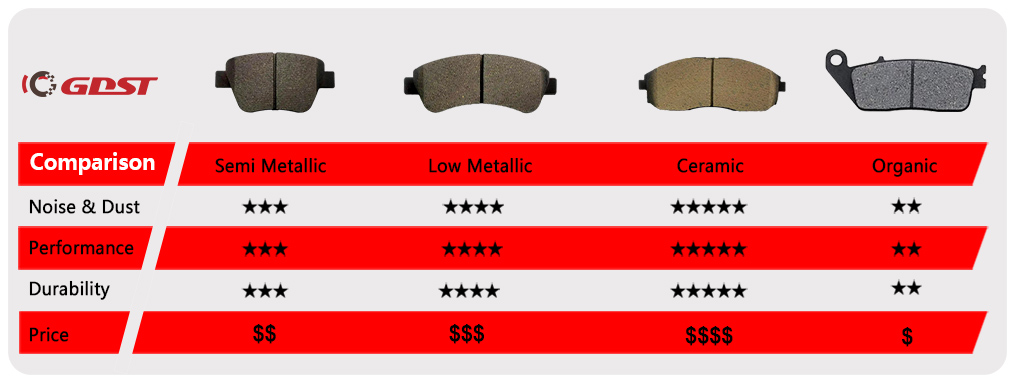Whether you are new to the brake pad import business or an experienced industry veteran, this article will provide you with valuable knowledge and insights. Gain a deeper understanding of brake pad importation, expand your horizons, and stand out in the competitive market.
Overview of The Brake Pad Market

According to the 2023 Automotive Brake Pads Global Market Report, in 2023, the market is estimated at $8.26 billion and is expected to grow at a compound annual growth rate (CAGR) of about 6.7% to reach about $10.52 billion by 2027.
The expansion of the automotive market directly drives the growth of the brake pads market. As the number of vehicles worldwide increases, especially in countries with rapidly developing economies, the demand for brake pads is also growing. This is because, with the increase in people’s income and the advancement of urbanization, more and more people can afford cars, thus increasing the number of cars owned. The more cars there are, the greater the demand for critical safety components like brake pads.
The Asia-Pacific region, home to major automobile manufacturing countries such as China, Japan, and India, has become a major center for brake pad production and is also the region where demand for brake pads is growing the fastest;
In North America, especially the United States, the brake pad market has grown due to stringent safety regulations and the presence of major automobile manufacturers and suppliers There was strong support. There is steady demand for high-quality brake pads in the region;
Europe is known for its high safety standards and the presence of leading carmakers such as Continental and Robert Bosch. This market has strong demand, especially for technologically advanced brake pads for high-performance and luxury vehicles.
Overview of Brake Pads
Brake pad materials vary based on different formulations and can generally be categorized into 4 types: ceramic, low-metal, semi-metallic, and organic. You can choose the material that best suits your market’s needs.

Types of Brake Pads
- Ceramic Brake Pads: are mainly made of ceramic materials, without any metal. They have the best braking performance, highest durability, longest lifespan, no noise, and are suitable for high-speed driving or racing cars.
- Low-metallic Brake Pads: are made of carbon steel with a small amount of metal. They have better braking performance, lower wear resistance, longer lifespan, and less noise, and are suitable for regular cars and SUVs.
- Semi-metallic Brake Pads: are mostly made of carbon steel, some metal powders, and fillers. They have better braking performance, higher wear resistance, longer lifespan, acceptable noise levels, and are suitable for cars, SUVs, trucks, etc.
- Organic Brake Pads: are mainly composed of organic resin, fillers, and friction materials, without any metal. They offer soft braking, moderate wear rate, shorter life, and average noise, and are suitable for city commuter cars or motorcycles.
How To Find Reliable Brake Pad Manufacturers?
Do you know all the ways to find a brake pad supplier? Here I have listed a few of the more practical ones that will help you.
1. Using Search Engines

Use search engines like Google, and key in some keywords such as “brake pad suppliers” or “brake pad manufacturers” with your favorite location to find some potential suppliers.
2. Using B2B Platforms

Search brake pad suppliers on B2B platforms such as Alibaba, Global Sources, Made In China, or ThomasNet. These platforms gather a lot of vendor information. You can find the suppliers and contact them to get the most suitable one.
3. Using Social Media

Generally, suppliers advertise their products and companies on various social media. You can find them on Facebook, Linkedin, INS, and other social media to read their posts and indirectly understand their business scope and reputation.
4. Attending Exhibitions

Visit exhibitions in the automotive industry, which is a good chance to meet suppliers face to face. You can communicate with suppliers directly to check the quality of their products, production capability, and cooperation methods.
5. Find A Purchasing Agent

Try to find a professional purchasing agent or trading company. They usually have rich supply chain resources, can help you find some quality brake pad suppliers, and assist you with procurement negotiation and quality management.
6. Industry Associations and Trade Groups

Join associations or trade groups in the automotive industry. They often provide the latest supplier information and resources in the industry, but also can help you build industry contacts, and get more cooperation opportunities and advice.
Criteria for Selecting Brake Pad Suppliers

Choosing the right brake pad supplier involves considering several key criteria to ensure you get high-quality products and reliable service. Here are some important standards to consider when selecting a brake pad supplier:
Quality Assurance
- Check if your supplier has any industry-recognized quality certifications, such as ISO/TS 16949, which is a quality management system standard for the automotive industry.
- Understand their brake pad manufacturing processes and quality control measures. You must ensure their brake pads meet strict safety and performance requirements.
Cost-Effectiveness
- Compare prices from different suppliers to ensure you get the most cost-effective quotation without compromising on quality.
- Consider the total cost, including the unit price of the brake pads, shipping costs, tariffs, and other logistics costs.
Supply Chain Stability
- Evaluate the supplier’s delivery record and ability to manage their supply chain. A reliable supplier should ensure stable supply even when market demands fluctuate.
- Ask the suppliers how they have handled the market changes or supply disruption before.
Customer Service and Technical Support
- Choose a supplier who can offer you great customer service, especially timely support in solving technical problems and handling emergencies.
- Understand your supplier’s after-sales service policies and customer feedback to ensure they can help you when you need them.
Market Reputation and Experience
- Check the supplier’s reputation and experience in this industry. The suppliers who have been in the market for a long time should be more reliable and have extensive industry knowledge and a stable customer base.
- Get information about the supplier’s performance and reputation from industry contacts, trade shows, or your peers.
4 Tips for Vetting Suppliers No One Will Tell You

Request Samples
Request brake pad samples from potential suppliers so you can test their quality, performance, and compatibility with different vehicle models. You can conduct thorough testing and evaluation before making a decision.
Visit the Factory
If you can, go to the factory by yourself. Then you can see their production line, quality control system, and overall operations.
Background Check
- Learn about the background of the supplier. When did they start their business? What’s their reputation?
- Check if their financial condition is good. Do they have enough money to support their business?
- Verify the authenticity and validity of the certificates and certifications they provided. Do they have ISO9001 and ECE R90?
Negotiate Terms
Agree on various contract conditions with your suppliers and ensure they meet your business goals and needs. This includes:
- Price: Negotiate the price of your product or service with your supplier.
- Payment terms: Determine the method, time, and conditions of payment, such as advance payment ratio, payment term, etc.
- Delivery Time: Agree on the specific time and method of delivery of goods to ensure that products are received on time.
- Other contract terms: may include quality guarantee, after-sales service, contract period, liability for breach of contract, and other important details.
Choosing the Right Shipping Method

Air Freight:
- There are weight and volume restrictions on packages, and bulk goods need to be split;
- delivery is fast, usually 7-10 days, and the cost is high;
- suitable for high-value, small-volume, light, and heavy goods.
Sea Freight:
- volume and weight restrictions are loose, and brake pads usually do not exceed the limit;
- shipping is slow, taking more than a month, but the cost is cheaper;
- suitable for large quantities of goods, full container or combined container options are available.
Railway Freight:
- the railway is faster than the sea, is less affected by weather, and is cost-effective;
- suitable for land, especially areas with good railway networks, such as Europe and Asia.
Understanding Incoterms 2010

Incoterms (International Commercial Terms) define the responsibilities of buyers and sellers for the delivery of goods under sales contracts. You can check the above picture carefully and learn more about their implications on shipping responsibilities and costs.
Key terms include EXW (Ex Works), FOB (Free on Board), CIF (Cost, Insurance, and Freight), DAP (Delivered at Place), etc. Each term delineates the points where costs and risks transfer from the seller to the buyer.
It is very important to understand these terms, for they have a great impact on the pricing strategies, risk control, and logistics arrangement of an importing business.
Customs Clearance Procedures and How to Handle Them

You can hire an experienced customs broker or agent who can simplify the process. They can provide valuable advice on local regulations, prepare documentation, and handle the actual customs clearance process.
Prepare Documents:
When the goods arrive at your port of destination, the local customs will inform you by email or phone and ask you to prepare the customs clearance documents. Then please ensure all necessary docs, e.g. Commercial Invoice, Packing List, CO, and B/L, are properly completed and provided, otherwise, there will be a delay or even confiscation for the shipment.
Pay Tariffs and Taxes:
After submitting the customs clearance documents, the local customs will notify you to pay taxes by email after the inspection of the goods. Please note what duties and taxes apply in your destination country. These fees can be significant and affect the total cost of the item.
The customs website of most countries provides a tariff inquiry function, you can find the relevant entry by searching “tariff inquiry” or “Customs tariff”.
For Examples:
Country
Saudi Arabia
Bolivia
Venezuela
Peru
United States
Mexico
Indonesia
Egypt
Libya
Algeria
Duty Rate
15%
10%
20%
17%
3-25%
15%
10%
20%
15%
30%
Website
Saudi Arabian Customs Administration
Bolivian Customs Administration
Venezuelan Customs Administration
Peruvian Customs Administration
U.S. Customs and Border Protection
Mexican Ministry of Finance and Public Credit
Indonesian Customs Administration
Egyptian Customs Administration
Libyan Customs Administration
Algerian Customs Administration
The above information is for your reference only, and the actual rate may change. Please consult with local customs or trade authorities to obtain the most up-to-date information.
Receive Cargos
After you submit the customs clearance documents and pay the taxes, the customs will release your goods in a few days, and your forwarder will smoothly deliver the goods to the place you specify.
That’s all the process of customs clearance. Hope the above information can help you better understand the customs clearance process.
Conclusion
In this guide, we explain every step of how to import brake pads. We first look at the demand for brake pads around the world and then teach you how to find a good brake pad supplier, as well as logistics and shipping terms. Hopefully, this guide will help you do business and be successful in the world market.




